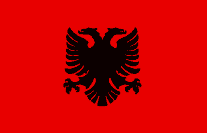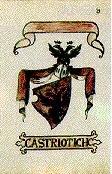Albania
 Gules, a
double-headed eagle sable. The eagle goes back to George Kastriotialso
known as Iskander Bey, or Skanderbeg
(see below), who led the fight of the Albanians
against the Turks in the 1440's. He used the Byzantine two-headed eagle
on his seals, hence the modern flag. The modern flag had at various times
a crown or a star above the eagle. the star Gules lined Or dates to the
Communist takeover in 1946, and has been recently removed.
Gules, a
double-headed eagle sable. The eagle goes back to George Kastriotialso
known as Iskander Bey, or Skanderbeg
(see below), who led the fight of the Albanians
against the Turks in the 1440's. He used the Byzantine two-headed eagle
on his seals, hence the modern flag. The modern flag had at various times
a crown or a star above the eagle. the star Gules lined Or dates to the
Communist takeover in 1946, and has been recently removed.
The violation of the usual tincture rule may not necessarily be due
to the fact that it is a flag rather than "real" arms: see the
Subic arms of Bosnia, which were Gules, a wing displayed sable.
The Castriota Family
 The Kastrioti
or Castriota family, of Albanian origin, begins with certainty with John
Castriota, lord of Mat and Vumenestia, who died in 1443. He resisted Turkish
attempts at conquering the Albanian region. At one point, he had to give
his four sons as hostage to the Turks. One of them, George Castriota (1403-68),
was raised at the Ottoman court and given the name Iskander-Bey (Skanderbeg).
He became Christian again, and led Albanian resistance to the Turks to
become prince of Albania. He was allied with Venice, which inducted him
in its nobility in 1463, but also with the king of Naples, who gave him
the lordships of Monte S. Angelo and S. Giovanni Rotundo in the Gargano
region of Naples in 1463.
The Kastrioti
or Castriota family, of Albanian origin, begins with certainty with John
Castriota, lord of Mat and Vumenestia, who died in 1443. He resisted Turkish
attempts at conquering the Albanian region. At one point, he had to give
his four sons as hostage to the Turks. One of them, George Castriota (1403-68),
was raised at the Ottoman court and given the name Iskander-Bey (Skanderbeg).
He became Christian again, and led Albanian resistance to the Turks to
become prince of Albania. He was allied with Venice, which inducted him
in its nobility in 1463, but also with the king of Naples, who gave him
the lordships of Monte S. Angelo and S. Giovanni Rotundo in the Gargano
region of Naples in 1463.
He left a son by Andronica Arianiti Comnena, Giovanni Castriota (ca.
1450-1514), who ceded his rights in Albania to Venice in 1474 and retired
in the kingdom of Naples. He exchanged his possessions for the marquisate
of Soleto and the county of San Pietro in Galatina (both near Lecce) in
1485. In 1497, he was elevated to the rank of duca di San Pietro. He married
Irene Palaiologa, daughter of Lazare despot of Serbia, and left 3 or 4
sons: Costantino, bishop of Isernia (died 1500), Ferrante who succeeded
as duke, Giorgio (died 1540, leaving one son without issue), and perhaps
Federico. It is said that this line died with Irene, sole surviving child
of Ferrante, married in 1539 to Pietrantonio Sanseverino, prince of Bisignano.
Among the illegitimate children of Ferrante, two had issue: Achille, born of
Dianora, a Greek slave from Corone freed by the duke, whose descendants
now live in Naples; and Pardo, son of Porzia de Urrisio, made a patrician
of the city of Lecce, whose descendants live in Lecce and Ruffano.
A member of that branch was Isabella Castriota Scanderbeg (1704-49), a poet.
The family still exists. The current (or at least recent) head of the
family of Castriota-Scanderbeg lives at "Napoli: via G. Cotronei 2",
while his uncle lives at "Napoli: villa Scanderbeg, via Napoli 119
bis; La Pietra- Bagnoli (Napoli)". They bear the arms d'oro all'aquila
bicipite, coronata sulle due teste di nero, col volo abbassato, alla punta
d'azz., movente dal lembo superiore dello scudo, rovesciata e caricata
di una stella (6) d'oro (which translates into Or an double-headed
eagle, wings abaisse, crowned on both heads sable, on a pile azure a mullet
or.)
A brother of George Castriota Scanderbeg was Stanisha (Staniscia), who
left a son Branilo. Raised as an Ottoman under the name of Hamsa, he became
Christian in 1443, count of Mat, governor of Croia in Albania, was made
duke of Ferrandina in the kingdom of Naples and died in 1463. By Maria
Zardari he had Giovanni, duke of Ferrandino who left a daughter Maria;
and Alfonso, marquis of Altripalda in 1512 (died 1544). Some source
give him a son
Antonio Branai who married his cousin Maria and became duke of Ferrandina.
Antonio had no legitimate issue, but a natural son Alessandro
d'Altripalda whose descendants formed a prominent family of the Napolitan
aristocracy ad were were given the name Castriota in 1803. Others
say that this is a confusion, and that this Castriota family descends
from Bernardo Granai, a lieutenant of Scanderbeg.
Recently (according to the Electronic Telegraph of May 8, 1997) Giorgio
Castriota Scnaderbeg, a bank employee near Naples, has made a claim to
the Albanian throne. Isabella Stasi Castriota
Scanderbeg, an Italian TV documentary writer and producer who lives
in Rome and Cadaqués;, may belong to the Catriota d'Altripada family.
Sources:
- Enciclopedia Italiana.
- Enciclopedia Storico-Nobiliare Italiana.
- Dizionario Biografico degli Italiani.
- Charles Hopf: Chroniques Gréco-Romaines. Berlin, 1873.
- Foscarini, Amilcare: l' Armerista delle famiglie nobili e
notabili in terra d'Otranto, 1927.
The Albanian College of Arms
Please see James Algrant's article
on this organization.
Last modified:
 Gules, a
double-headed eagle sable. The eagle goes back to George Kastriotialso
known as Iskander Bey, or Skanderbeg
(see below), who led the fight of the Albanians
against the Turks in the 1440's. He used the Byzantine two-headed eagle
on his seals, hence the modern flag. The modern flag had at various times
a crown or a star above the eagle. the star Gules lined Or dates to the
Communist takeover in 1946, and has been recently removed.
Gules, a
double-headed eagle sable. The eagle goes back to George Kastriotialso
known as Iskander Bey, or Skanderbeg
(see below), who led the fight of the Albanians
against the Turks in the 1440's. He used the Byzantine two-headed eagle
on his seals, hence the modern flag. The modern flag had at various times
a crown or a star above the eagle. the star Gules lined Or dates to the
Communist takeover in 1946, and has been recently removed.  The Kastrioti
or Castriota family, of Albanian origin, begins with certainty with John
Castriota, lord of Mat and Vumenestia, who died in 1443. He resisted Turkish
attempts at conquering the Albanian region. At one point, he had to give
his four sons as hostage to the Turks. One of them, George Castriota (1403-68),
was raised at the Ottoman court and given the name Iskander-Bey (Skanderbeg).
He became Christian again, and led Albanian resistance to the Turks to
become prince of Albania. He was allied with Venice, which inducted him
in its nobility in 1463, but also with the king of Naples, who gave him
the lordships of Monte S. Angelo and S. Giovanni Rotundo in the Gargano
region of Naples in 1463.
The Kastrioti
or Castriota family, of Albanian origin, begins with certainty with John
Castriota, lord of Mat and Vumenestia, who died in 1443. He resisted Turkish
attempts at conquering the Albanian region. At one point, he had to give
his four sons as hostage to the Turks. One of them, George Castriota (1403-68),
was raised at the Ottoman court and given the name Iskander-Bey (Skanderbeg).
He became Christian again, and led Albanian resistance to the Turks to
become prince of Albania. He was allied with Venice, which inducted him
in its nobility in 1463, but also with the king of Naples, who gave him
the lordships of Monte S. Angelo and S. Giovanni Rotundo in the Gargano
region of Naples in 1463.